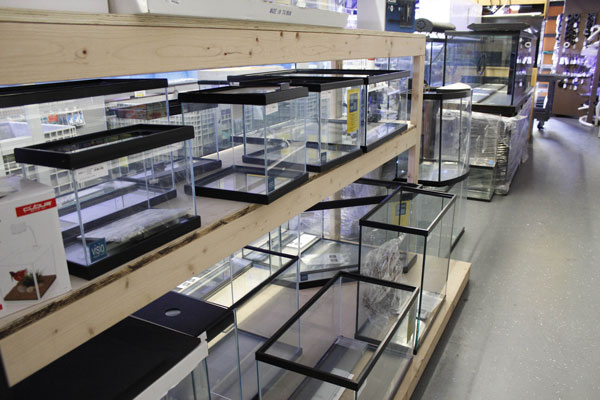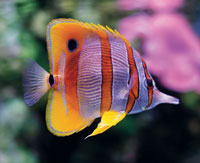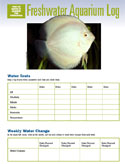
Our hobby has grown from its simple roots into a high-tech pastime that is only limited by our imaginations. Although today’s hobby is enlightened and complex, some areas have remained attached to traditional practices. It is widely understood that goldfish were the backbone of this hobby, but with them came the goldfish bowl, and therein lies the problem.
Every year, around the world, thousands of these bowls are used to house goldfish that die of suffocation. This led us at “Timeline” to wonder where people got the idea that a goldfish can be happily maintained in a goldfish bowl. It would seem logical that this idea was handed down from the early days of the hobby, but it might surprise you to learn that the goldfish bowl, or globe, was never an accepted practice in the American aquarium literature. It is also interesting that like the goldfish bowl itself, the reason for such misinformation has not changed for at least 130 years.
The Wrong Home
The idea of goldfish being a poor choice for a goldfish bowl may seem strange. First and foremost, goldfish are large animals that can attain an adult size that may be twice as large as the bowl itself. A comet goldfish (the kind often won at fairs or sold as live food in pet stores) can attain lengths of 10 inches, while an oranda can fill a large man’s palm easily.
In addition to their size, they are dirty animals that pollute their environment if it isn’t properly maintained. Yet, there are other concerns in regards to keeping one of these gentle giants in a bowl, such as the shape of the bowl itself. The oxygenation process takes place at the surface of the water. This is often misunderstood by beginning hobbyists. Many see air pumped into an aquarium and conclude this is how oxygen is dissolved in water, but it is not that simple.
The fine mist of bubbles are doing nothing more than pushing the under water to the surface where it comes in contact with the atmosphere, which oxidizes the water. In a bowl there is little surface area in relation to the volume of water contained, so the fish are quickly suffocated. In other words, the bowl’s very shape proves detrimental to the goldfish.
Another problem with the design of a bowl or globe is that the curve of the glass makes it hard to see the animal, and it also makes it hard for the animal to see its host. It is for this reason that the goldfish bowl was recently banned in Rome; the lawmakers stated that they believe the curve of the glass could make fish go blind.
Lastly, goldfish are long-lived animals. I have read books that say they can live up to 100 years, but I have seen no evidence of this. However, I have known more than one person who has kept them for as long as 30 years. For this reason it seems logical that if you are going to try to keep such an animal, care should be taken to provide it with the environment required to maintain it properly.
Global History
What is interesting is that none of these facts are new to aquarium literature. They have been understood from the beginning of the hobby.
Although it is true that very early on in development of the modern aquarium hobby bowls were commonly used for everything from saltwater fish setups to goldfishkeeping, this practice was quickly replaced by good sense. By the time aquariumkeeping took hold in the United States, the general sentiment was against using bowls for keeping goldfish. In 1910, Hugo Mulertt said, “The old-fashioned fish globe is about the worst vessel that can be selected for the keeping of goldfish as pets; it will do well enough for a temporary display of the fish, but for permanent use it will not answer.”
In a 1902 issue of Freshwater Aquaria, G. Bateman remarked, “Another receptacle for water and fish is the common glass globe, which has nothing whatever to recommend it, except perhaps to those who delight to hang their unfortunate captives suspended by a chain from the ceiling in front of the window; and of course an aquarium which is to be placed in this position — the worst possible — must, on account of its weight, be small; besides, if full, the surface of the water exposed to the air must be extremely limited.”
The rectangular iron-rimmed aquarium was no accident, instead it was developed out of necessity because the common bowl killed fish.
The Hobby’s Insight
All of the hobby’s greatest names were in agreement on the subject. In 1908, Herman T. Wolf said this about the goldfish bowl, “Cruelty to fishes. All admirers of the aquarium should consider it a duty to direct attention to the pernicious practice of keeping fishes in small fish globes. Millions of goldfishes have been killed by slow torture in this regrettable precursor of the modern aquarium and by other unintentional cruelties.”
Time would not change this opinion either. Deep into the Great Depression era, the message was the same: “Globes and bowls are not suitable for fish! These vessels are undesirable for several reasons, perhaps the most important being the fact that the fish cannot be properly observed in a container of their shape. The curved glass sides distort vision so that the fish assume grotesque shapes and are usually out of line of vision. Another very important factor in the elimination of the globe is the limited water surface that comes in contact with the atmosphere,” said C. H. Peters in his Life and Love in The Aquarium, 1935.
You may begin to wonder how the goldfish bowl ever made it this far. Not everyone was against using a bowl to house goldfish. In fact, some spoke very strongly in favor for it.
Today, as then, there are people who profit from selling bowls for goldfish. One of the first books to be written for marketing via pet stores was Vincent Sanford’s tiny book entitled Aquaria. On page 43 you see a stark contrast to the experts’ opinions:
“We want to say a word right here in favor of the much abused round fish globes. It is difficult to find any book on this subject which does not condemn these globes, but the leading book on this subject now on the market is published by a manufacturer of square aquariums.
“The main objection to the fish globe is that the inhabitants are magnified and apparently distorted in shape when you look through the glass at them, especially in smaller sizes of fish globes, but thousands of people keep goldfish who cannot afford to have a square aquarium, or who think that the fish globes are more ornamental for the parlor than the square aquariums which take so much more room.”
Changing Attitudes
Why such a difference? It would seem it was because this book was to be marketed through the trade that profited from selling goldfish to be kept in bowls. Even the way the fish bowls were, and still are, marketed pushes the idea that a goldfish is fine in a bowl. I have used the phrase “goldfish bowl” through this entire article just to make a point.
For some reason we have been programmed to connect the goldfish and the bowl. Is this all because of greedy marketers who want to make a profit? In a word, no! I believe this perception runs much deeper. Popular culture has glorified the goldfish bowl, and a picture is worth a thousand words.
Goldfish don’t fare well in bowls and never will. Remember that within history’s archives there is a line drawn, and it is there that we will meet again when “Timeline” investigates.
 Reefdoser Pro for iPad Ships
Reefdoser Pro for iPad Ships
 Five Tips for Freshwater Aquarium Success
You spent countless hours researching the latest products to
Five Tips for Freshwater Aquarium Success
You spent countless hours researching the latest products to
 Pufferfish Teeth Care
Because their teeth are constantly growing, pufferfish
Pufferfish Teeth Care
Because their teeth are constantly growing, pufferfish
 Aiptasia Anemone
Aiptasia Anemone
 Aquarium maintenance logs for freshwater, saltwater and reefkeeping aquarists
Thank you for signing up for the FishChannel newsletter, the
Aquarium maintenance logs for freshwater, saltwater and reefkeeping aquarists
Thank you for signing up for the FishChannel newsletter, the
Copyright © 2005-2016 Pet Information All Rights Reserved
Contact us: www162date@outlook.com